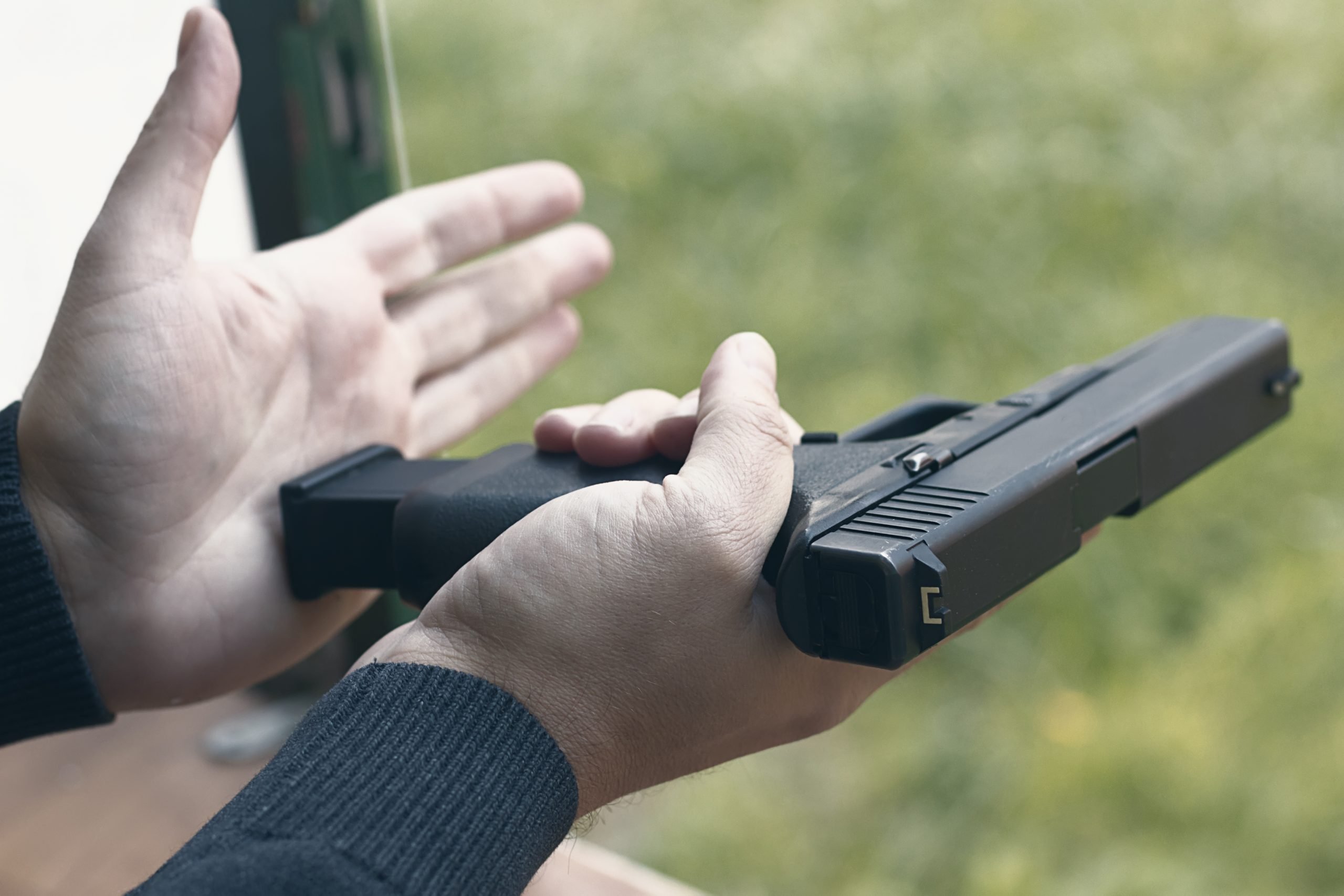BLOG CATEGORIES
Your Emergency Action Plan : Addressing an Active Shooter

Active shooter preparedness has, unfortunately, become an essential part of property emergency response. Learn tips you can give your tenants, employees and visitors should they ever face an active shooter or other violent situation at your building or property.
How upsetting and scary is it that active shooter events have become so commonplace that it is considered a necessary component of emergency preparedness to create procedures and protocol centered around the issue? Don’t worry, this isn’t another article discussing the politics behind such happenings. Explaining why active shooter events occur does not fall under our expertise, and while we don’t think it’s right or fair that people are living in fear of active shooters, the fact of the matter is- this is a part of our current landscape.
Find out how to improve safety and reduce costs at your property
Our best-in-class emergency phone + monitoring solutions provide peace of mind and are backed by decades of expertise
Learn More

2024 ELLIES WINNER
Best Supplier -
Communication System
Find out how to improve safety and reduce costs at your property
Our best-in-class emergency phone + monitoring solutions provide peace of mind and are backed by decades of expertise
Learn More
2024 ELLIES WINNER
Best Supplier -
Communication System
It is essential to have emergency response procedures developed for tenants to follow in case of an active shooter event on your property. As many precautions as you take and safeguards that you put in place, there is no foolproof guarantee that can prevent an active shooter event at your building or on your property.
Download our FREE Guide: Building Your Emergency Action Plan >>
Tips for Identifying Potential Threats
While none of us can prevent an active shooter incident from occurring, there are measures we can all take to help identify potential threats. Consider the following:
- Make sure you have a system for which tenants can report inappropriate behavior and perceived threats. Make reporting anonymous if you believe it will encourage others to come forward. If you manage office space, encourage your tenants to have such a system in place for their employees.
- Within that system, develop a means of assessing the threat at hand and determining when a threat should be escalated. Office space tenants should be encouraged to notify property management of escalated threats.
- Sign up to be informed of local emergency alerts to be made aware of threats and dangers in your nearby environment.
- Monitor and regulate visitor access. Be able to identify all those who enter the property and determine why they are there. Predetermine criteria on who is allowed on the property and the proper actions to take should someone not fit the criteria. Learn more about entry access and building security measures: Specializing Life Safety & Security for Your Property.
- Last, but certainly not least: educate your tenants. Hold on-site educational meetings and supplement with sending out regular communication on emergency procedures for your building. For an on-site meeting, it would be worthwhile to reach out to your local police department for assistance with tips and guidelines. Depending on your location and police force capacity, the department may be able to provide assistance in-house or can provide you with a retired law enforcement officer or other subject matter expert to help lead the discussion and provide useful tactical information on how to respond in this situation and more. Some useful references regarding an active shooter:
As the property manager, you are required to provide an Emergency Action Plan (EAP) for the building that you manage. Not only does the EAP outline emergency training, contacts, and personnel, but the most effective EAP’s are those that are comprehensive- they include emergency procedures for tenants to follow for specific dangers that may occur on the property. This includes emergencies such as fires, natural disasters, bomb threats and, recently, active shooters. Below, we have outlined a distinct procedure that building tenants may follow in an active shooter situation.
Active Shooter Emergency Procedure
- If there are reports of active shooter in the building, and it is possible for you to safely and quickly get out, do so via your nearest exit.
- If you are able to hear shots being fired, do not wait for instructions from others. Get out as quickly as possible, leaving any belongings behind.
- Once you are out of the building and in a safe location, dial 911 and provide as much information as possible. Notify those nearby to stay away from the building.
If the shooter is blocking you from your method of exit, follow these guidelines:
- Search for a hidden and/or protected room to hide within. Avoid any locations that may hinder your ability to move. If possible, try to find a room with a locked door.
- If unable to find a room with a locking door, create a barricade at the door using the heaviest objects that you can find.
- Once within the room, turn off all lights and anything that may make any noise.
- Remain silent. Only call 911 if you believe that you are able to do so without notifying the shooter of your location.
- If you are with other people, disperse to different locations to prevent the shooter from finding multiple people at once.
Face-to-Face with an Active Shooter
Should you come face-to-face with the shooter, do whatever it takes to survive. Fight back using improvised weapons. Scream and shout. Obviously, you should take any and all necessary actions that may lead to your safety.
An active shooter event is a terrifying situation and one none of us ever expects to encounter ourselves. Regular open communication about your building’s emergency action plan, and tips on how to identify potential threats and how to respond can help provide knowledge to your employees, tenants, and visitors should the need to access that information at a later date ever arise.
To learn about how Kings III helps property managers with emergency preparedness and emergency response, visit us at www.kingsiiii.com.
CATEGORIES TAGGED
ELEVATORS
PROPERTY SAFETY
CATEGORIES
KEEP LEARNING

Kings III Acquires LiftNet, Advancing Connected Safety & Remote Monitoring in Elevators and Escalators
Kings III Emergency Communications partners with Wurtec to enhance elevator video messaging systems, addressing new code requirements for two-way displays and video monitoring. The collaboration combines Kings III's emergency response expertise with Wurtec's industry solutions to provide streamlined, compliant elevator safety communications nationwide.

Is Your Pool’s Emergency Phone Compliant? Here’s How to Check (And What to Do If It Isn’t)
Is your pool’s emergency phone truly compliant and ready when it matters most? A reliable, code-compliant emergency phone is more than a regulatory requirement—it’s a critical lifeline that ensures immediate access to help during emergencies. This guide walks you through how to check compliance, properly test your phone, and take the right steps if it doesn’t meet current standards. Whether you're ensuring your current system is up to code or exploring a more dependable solution, we’ll help you navigate the process and safeguard both safety and liability.

8 Women Who Shaped the Future of Emergency Response & Dispatch
This Women’s History Month, Kings III is honoring the women who have paved the way in emergency response and dispatch. From breaking barriers in EMS to pioneering advancements in emergency communication, these trailblazers have helped shape the way lifesaving services operate today. See eight influential women whose contributions continue to impact the field and inspire future generations.

Honoring Black Pioneers: 7 Influential Figures in Emergency Communications & Response
This Black History Month, Kings III is honoring Black men and women who served as pioneers in the fields of emergency dispatch and emergency response. See 7 influential trailblazers who broke barriers, advanced life-saving technologies, and shaped the way emergency services operate today.

How Recent Spikes in Copper Theft Threaten Your Emergency Communication & What You Can Do About It
Rising copper theft is putting emergency communication systems at risk, leading to potential service outages. Without a reliable backup, property managers may face compliance issues and safety concerns. Learn more about the threat and how a cellular solution can help protect your property.

Is Your Hotel’s Emergency Communication System Up to Code?
Hotel emergency communication systems must meet strict safety and compliance standards, but are yours up to code? From elevator phones to pool and parking lot emergency call systems, we break down key requirements and how to ensure your property stays compliant.

Kings III & Wurtec Partner to Improve the Emergency Communication Market of Elevator Video Messaging Systems
Kings III Emergency Communications partners with Wurtec to enhance elevator video messaging systems, addressing new code requirements for two-way displays and video monitoring. The collaboration combines Kings III's emergency response expertise with Wurtec's industry solutions to provide streamlined, compliant elevator safety communications nationwide.

Updated Elevator Code: Who are my Authorized Personnel?
Confused about who qualifies as "authorized personnel" under the new ASME 17.1 elevator code? Learn why the same authorized staff must monitor all emergency communications—audio, video, and messaging—and why split monitoring solutions won't meet compliance requirements for your building's safety system.

What an Emergency Dispatcher will Most Likely Ask You
When suddenly faced with an emergency, you may immediately feel frightened and helpless. An emergency communications system can help reduce or eliminate those reactions by providing immediate assistance. Here's what you can expect on the other side of a call you place from an emergency phone.





